Strategy Implementation and Knowledge Management at Hikma Pharma
VerifiedAdded on 2021/04/16
|12
|3542
|34
Report
AI Summary
This report provides a comprehensive analysis of strategy implementation and knowledge management within Hikma Pharmaceuticals, focusing on its operations in the MENA region. It begins with an introduction to Hikma, its business challenges, and current strategic priorities. The report then delves into a business model analysis, comparing the current model with a suggested patient-centric model that emphasizes knowledge management and collaboration. Key areas of focus include people, culture, leadership, processes, and technology, with specific recommendations for research and development, supply chain and operations, and marketing and sales. The report highlights the importance of a Chief Knowledge Officer, cross-functional projects, and the use of data analytics and technology to improve efficiency and patient outcomes. The overall aim is to integrate knowledge management into Hikma's business strategy to achieve a patient-centric approach and gain a competitive advantage in the healthcare industry.
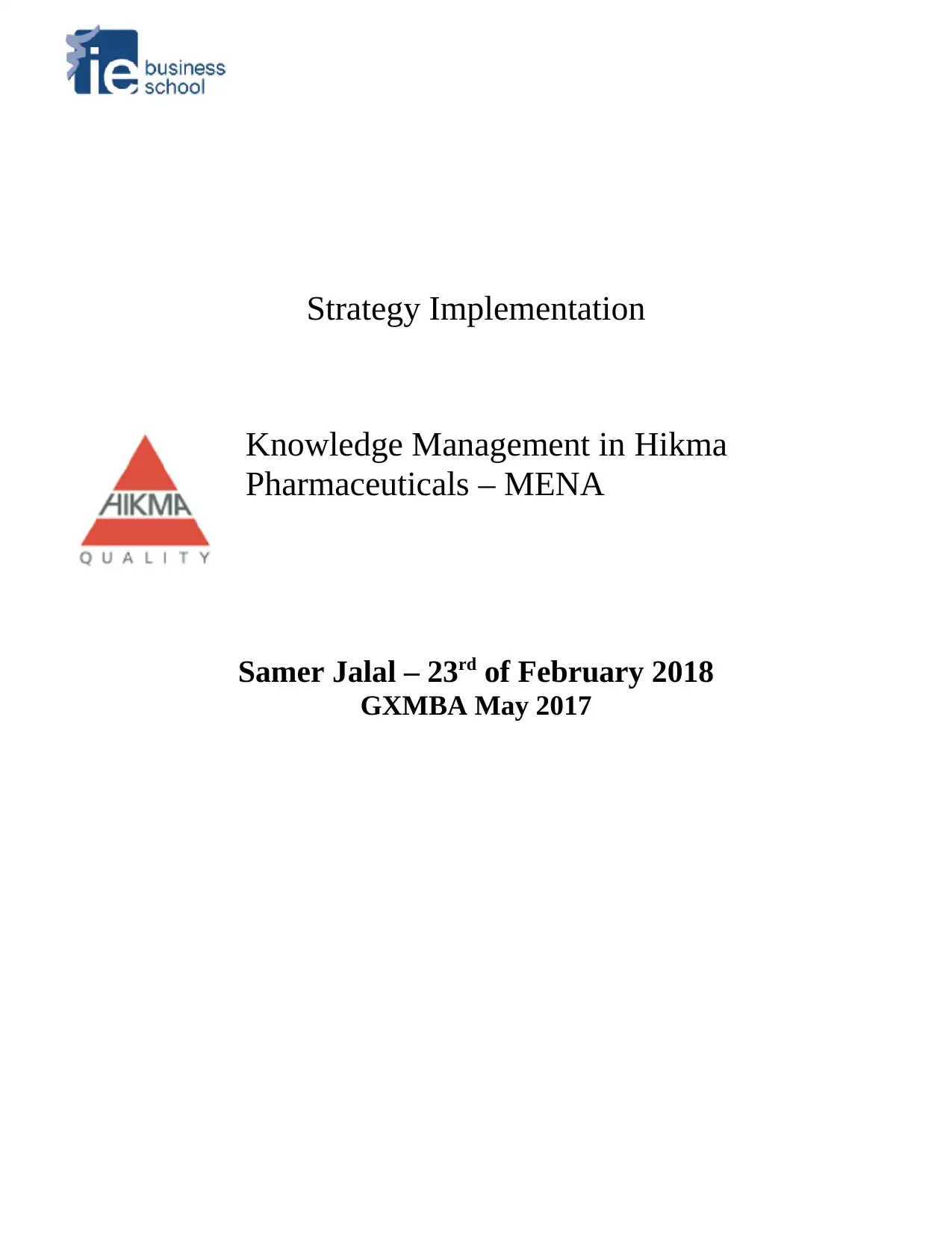
Strategy Implementation
Knowledge Management in Hikma
Pharmaceuticals – MENA
Samer Jalal – 23rd of February 2018
GXMBA May 2017
Knowledge Management in Hikma
Pharmaceuticals – MENA
Samer Jalal – 23rd of February 2018
GXMBA May 2017
Paraphrase This Document
Need a fresh take? Get an instant paraphrase of this document with our AI Paraphraser
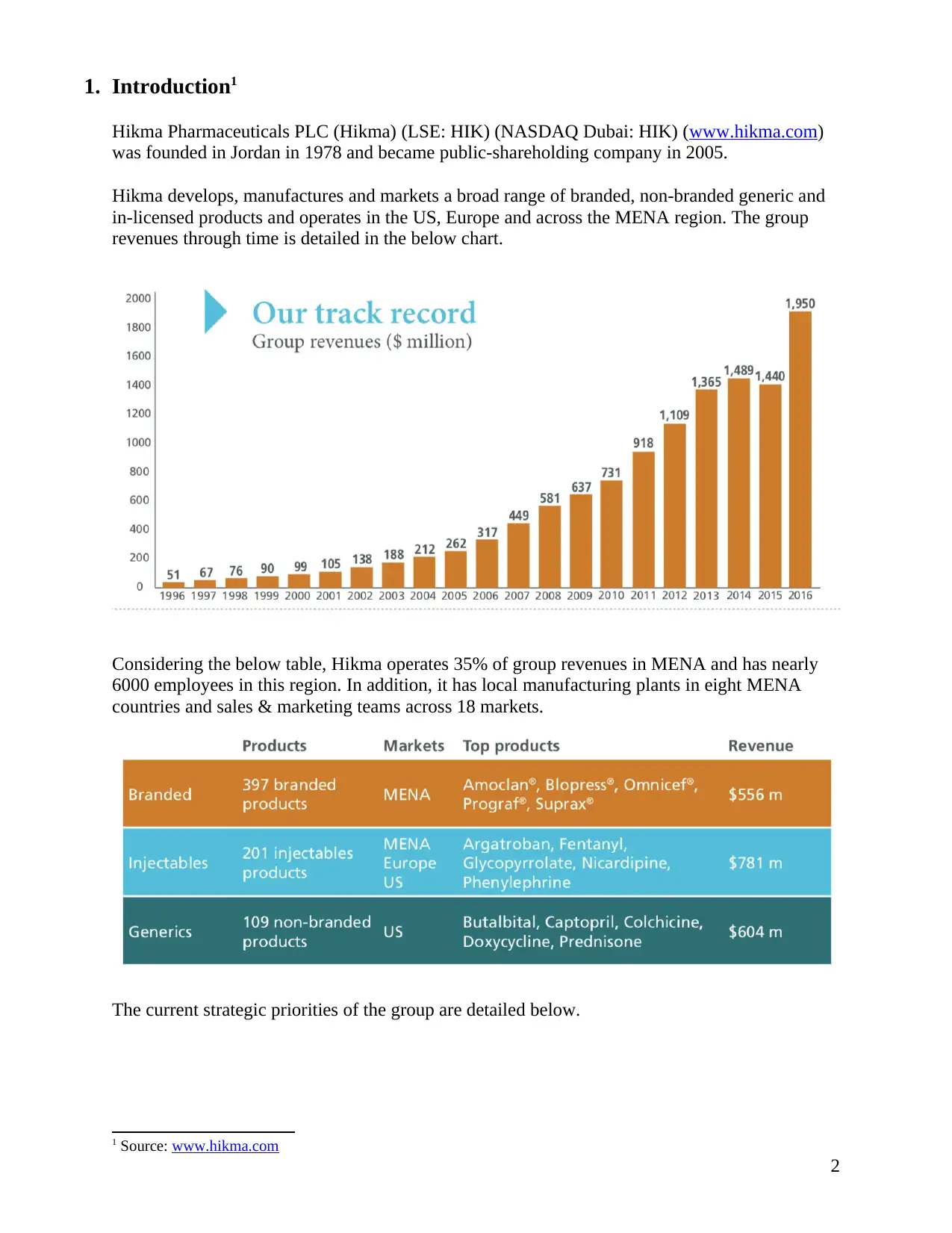
1. Introduction1
Hikma Pharmaceuticals PLC (Hikma) (LSE: HIK) (NASDAQ Dubai: HIK) (www.hikma.com)
was founded in Jordan in 1978 and became public-shareholding company in 2005.
Hikma develops, manufactures and markets a broad range of branded, non-branded generic and
in-licensed products and operates in the US, Europe and across the MENA region. The group
revenues through time is detailed in the below chart.
Considering the below table, Hikma operates 35% of group revenues in MENA and has nearly
6000 employees in this region. In addition, it has local manufacturing plants in eight MENA
countries and sales & marketing teams across 18 markets.
The current strategic priorities of the group are detailed below.
1 Source: www.hikma.com
2
Hikma Pharmaceuticals PLC (Hikma) (LSE: HIK) (NASDAQ Dubai: HIK) (www.hikma.com)
was founded in Jordan in 1978 and became public-shareholding company in 2005.
Hikma develops, manufactures and markets a broad range of branded, non-branded generic and
in-licensed products and operates in the US, Europe and across the MENA region. The group
revenues through time is detailed in the below chart.
Considering the below table, Hikma operates 35% of group revenues in MENA and has nearly
6000 employees in this region. In addition, it has local manufacturing plants in eight MENA
countries and sales & marketing teams across 18 markets.
The current strategic priorities of the group are detailed below.
1 Source: www.hikma.com
2
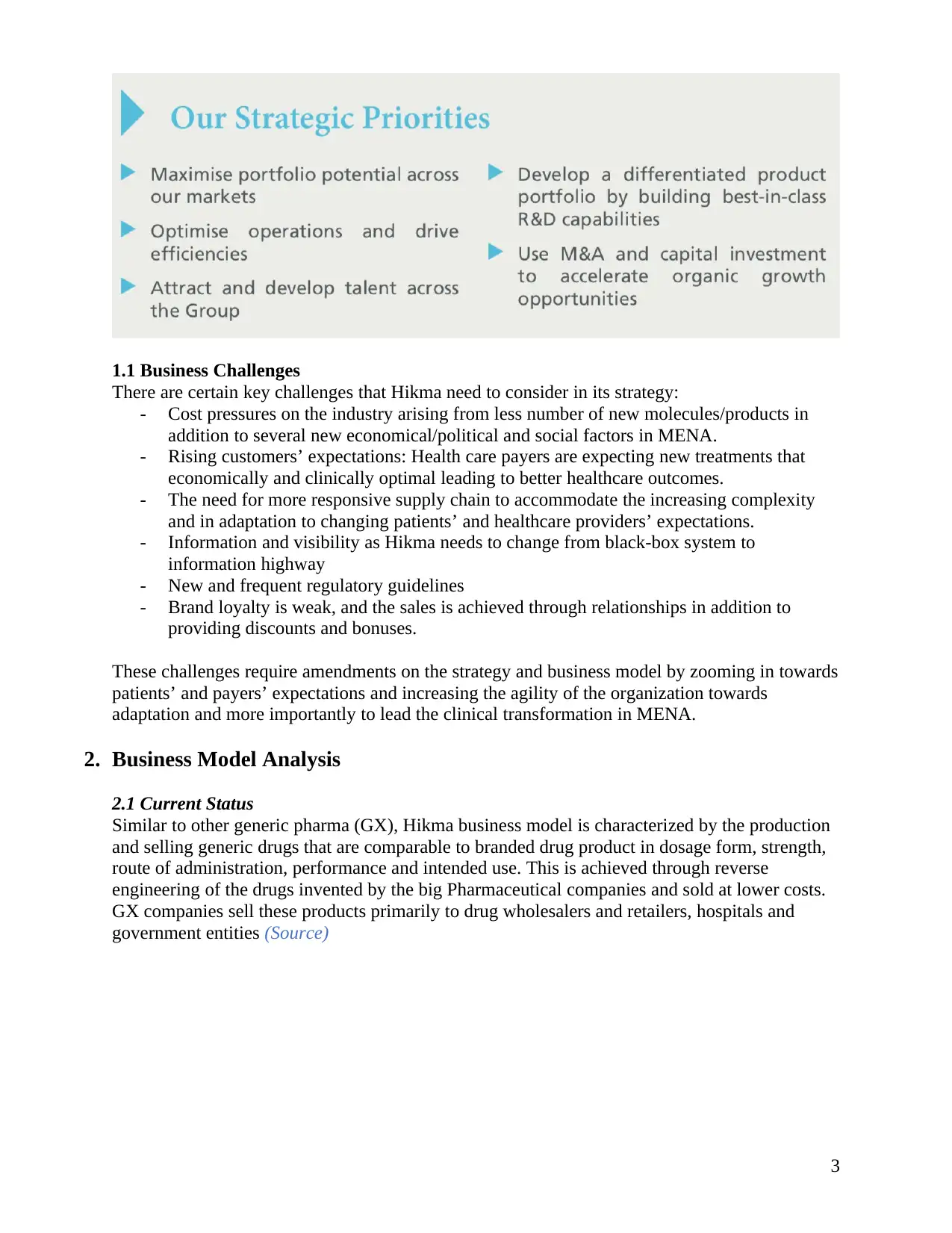
1.1 Business Challenges
There are certain key challenges that Hikma need to consider in its strategy:
- Cost pressures on the industry arising from less number of new molecules/products in
addition to several new economical/political and social factors in MENA.
- Rising customers’ expectations: Health care payers are expecting new treatments that
economically and clinically optimal leading to better healthcare outcomes.
- The need for more responsive supply chain to accommodate the increasing complexity
and in adaptation to changing patients’ and healthcare providers’ expectations.
- Information and visibility as Hikma needs to change from black-box system to
information highway
- New and frequent regulatory guidelines
- Brand loyalty is weak, and the sales is achieved through relationships in addition to
providing discounts and bonuses.
These challenges require amendments on the strategy and business model by zooming in towards
patients’ and payers’ expectations and increasing the agility of the organization towards
adaptation and more importantly to lead the clinical transformation in MENA.
2. Business Model Analysis
2.1 Current Status
Similar to other generic pharma (GX), Hikma business model is characterized by the production
and selling generic drugs that are comparable to branded drug product in dosage form, strength,
route of administration, performance and intended use. This is achieved through reverse
engineering of the drugs invented by the big Pharmaceutical companies and sold at lower costs.
GX companies sell these products primarily to drug wholesalers and retailers, hospitals and
government entities (Source)
3
There are certain key challenges that Hikma need to consider in its strategy:
- Cost pressures on the industry arising from less number of new molecules/products in
addition to several new economical/political and social factors in MENA.
- Rising customers’ expectations: Health care payers are expecting new treatments that
economically and clinically optimal leading to better healthcare outcomes.
- The need for more responsive supply chain to accommodate the increasing complexity
and in adaptation to changing patients’ and healthcare providers’ expectations.
- Information and visibility as Hikma needs to change from black-box system to
information highway
- New and frequent regulatory guidelines
- Brand loyalty is weak, and the sales is achieved through relationships in addition to
providing discounts and bonuses.
These challenges require amendments on the strategy and business model by zooming in towards
patients’ and payers’ expectations and increasing the agility of the organization towards
adaptation and more importantly to lead the clinical transformation in MENA.
2. Business Model Analysis
2.1 Current Status
Similar to other generic pharma (GX), Hikma business model is characterized by the production
and selling generic drugs that are comparable to branded drug product in dosage form, strength,
route of administration, performance and intended use. This is achieved through reverse
engineering of the drugs invented by the big Pharmaceutical companies and sold at lower costs.
GX companies sell these products primarily to drug wholesalers and retailers, hospitals and
government entities (Source)
3
⊘ This is a preview!⊘
Do you want full access?
Subscribe today to unlock all pages.

Trusted by 1+ million students worldwide

The current business model of Hikma Pharma is based on FIPCO model (Fully Integrated
Pharmaceutical Company) in which the company is active at all points of the value chain (R&D,
manufacturing up to commercialization). In addition, Hikma has alliance agreements with
different global partners to manufacture, market and sell licensed drugs in MENA region.
Hikma’s business, similar to other competitors, is mainly built on relationships and competitive
prices. Hikma sales force approach key physicians, health care organizations and key consultants
to introduce the drugs with continuous follow up visits on these parties to encourage writing
prescriptions containing Hikma drugs. Below figure explains the industry value chain.
As the company needs to react to the business challenges mentioned above (1.1), the healthcare
industry is also challenged with new business trends with emphasis on digital transformation and
the patients/customers are becoming smarter in choosing their treatments. Thus, Hikma needs to
leverage such new trend through a new business model that enables knowledge management and
collaboration as a way to differentiate its value from others.
2.2 Suggested Business Model
The move in the global healthcare industry is towards value and quality rather than quantity and
volume. The value/quality is anticipated as outcomes per cost and there is tremendous focus on
this direction being witnessed in several global countries.
The new business model needs to capture value through adopting patient-centric strategy in
which the patients are in the middle of the healthcare value chain and this would lead to the
necessity of increase in the collaboration between industry healthcare organizations in addition to
payers, universities, government agencies along with the software providers.
Hikma and other healthcare providers need to collaborate and achieve their objectives together.
Such model can be facilitated through incorporating of knowledge management strategy into the
business strategy (Source)
Hikma Physicians/
Hospitals
Patients/
Customers
4
Pharmaceutical Company) in which the company is active at all points of the value chain (R&D,
manufacturing up to commercialization). In addition, Hikma has alliance agreements with
different global partners to manufacture, market and sell licensed drugs in MENA region.
Hikma’s business, similar to other competitors, is mainly built on relationships and competitive
prices. Hikma sales force approach key physicians, health care organizations and key consultants
to introduce the drugs with continuous follow up visits on these parties to encourage writing
prescriptions containing Hikma drugs. Below figure explains the industry value chain.
As the company needs to react to the business challenges mentioned above (1.1), the healthcare
industry is also challenged with new business trends with emphasis on digital transformation and
the patients/customers are becoming smarter in choosing their treatments. Thus, Hikma needs to
leverage such new trend through a new business model that enables knowledge management and
collaboration as a way to differentiate its value from others.
2.2 Suggested Business Model
The move in the global healthcare industry is towards value and quality rather than quantity and
volume. The value/quality is anticipated as outcomes per cost and there is tremendous focus on
this direction being witnessed in several global countries.
The new business model needs to capture value through adopting patient-centric strategy in
which the patients are in the middle of the healthcare value chain and this would lead to the
necessity of increase in the collaboration between industry healthcare organizations in addition to
payers, universities, government agencies along with the software providers.
Hikma and other healthcare providers need to collaborate and achieve their objectives together.
Such model can be facilitated through incorporating of knowledge management strategy into the
business strategy (Source)
Hikma Physicians/
Hospitals
Patients/
Customers
4
Paraphrase This Document
Need a fresh take? Get an instant paraphrase of this document with our AI Paraphraser

This suggestion requires more emphasis on the patients’ health data and information and thus
collaboration between different healthcare organizations is necessary in this regard to be able to
build the necessary knowledge to increase the value and outcome effectiveness and reduce the
overall healthcare costs.
To achieve this model, Pharma companies such as Hikma needs to start learning about their
patients/customers and this would require more steps than just delivery of medicine to them as
this would also require more engagement with patients’ data and information to understand their
exact needs and behaviors in order to provide solutions that achieve healthier outcomes. Hikma
in this context, and through its sharing of data and information with other healthcare
organizations, need to start building new knowledge and disseminate it within itself and outside
to other collaborators to achieve the common objectives of healthier results.
Such complexity requires increased agility in responding to changing needs and with the new
business model, it’s expected company’s data and information will be dramatically increased and
knowledge management is needed in this case to structure the information and data in a traceable
way and utilize them to gain competitive advantage.
Knowledge management and collaboration need to be part of business strategy for Hikma to
achieve its patient-centric strategy. Knowledge management and collaboration reside in the core
of the business model and require the internal functions to deploy and manage knowledge
management systems and more importantly to instill a new culture that is characterized with
learning, innovation, continuous improvement, data-driven and efficiencies.
Knowledge Management can be defined as the process of creating, sharing, using and managing
the knowledge and information of an organization. It refers to a multidisciplinary approach to
achieving organizational objectives by making the best use of knowledge2
Hikma needs to capitalize on Knowledge Management throughout its business model and value
chain in fulfilment of the mission of achieving patients’ centricity.
2 https://en.wikipedia.org/wiki/Knowledge_management
5
collaboration between different healthcare organizations is necessary in this regard to be able to
build the necessary knowledge to increase the value and outcome effectiveness and reduce the
overall healthcare costs.
To achieve this model, Pharma companies such as Hikma needs to start learning about their
patients/customers and this would require more steps than just delivery of medicine to them as
this would also require more engagement with patients’ data and information to understand their
exact needs and behaviors in order to provide solutions that achieve healthier outcomes. Hikma
in this context, and through its sharing of data and information with other healthcare
organizations, need to start building new knowledge and disseminate it within itself and outside
to other collaborators to achieve the common objectives of healthier results.
Such complexity requires increased agility in responding to changing needs and with the new
business model, it’s expected company’s data and information will be dramatically increased and
knowledge management is needed in this case to structure the information and data in a traceable
way and utilize them to gain competitive advantage.
Knowledge management and collaboration need to be part of business strategy for Hikma to
achieve its patient-centric strategy. Knowledge management and collaboration reside in the core
of the business model and require the internal functions to deploy and manage knowledge
management systems and more importantly to instill a new culture that is characterized with
learning, innovation, continuous improvement, data-driven and efficiencies.
Knowledge Management can be defined as the process of creating, sharing, using and managing
the knowledge and information of an organization. It refers to a multidisciplinary approach to
achieving organizational objectives by making the best use of knowledge2
Hikma needs to capitalize on Knowledge Management throughout its business model and value
chain in fulfilment of the mission of achieving patients’ centricity.
2 https://en.wikipedia.org/wiki/Knowledge_management
5

3. Knowledge Management Strategy
To achieve integrating Knowledge Management into the business strategy, Hikma needs to
consider the following dimensions:
1- People, culture and leadership
2- Processes
3- Technology
3.1 People and Culture
Knowledge management strategy is a people strategy as people is the key to implement it;
processes and technologies are the tools for the effective implementation. Hikma needs to have
the buy-in from its people towards adoption, participation, sharing and utilizing knowledge. In
order to gain the buy-in, Hikma needs to manage this knowledge management project as
transformation/chain management project which and its suggested to follow the Knowledge
Management Strategy Implementation Plan (Point #5).
People in Hikma are talented and have very good understanding for the need of learning and
sharing; these people are coming from diverse cultures and backgrounds which will enable
achieving greater results and solutions once the knowledge management strategy has been
enabled. Currently these people are using their functional systems to manage their own processes
in their own departments. In order to activate the collaboration and sharing mode; Hikma needs
to start encouraging cross functional and cross-country projects to enable processes and data
standardization in addition to solving common business problems.
Motivation and incentives are key in this part and Hikma needs to redesign its objectives and
incentives to reward the good results of cross functional/geographical sharing of work.
Leadership
As knowledge management dimensions need to be integrated within Hikma strategy and
business model and because such new strategy requires hands-on and high-level empowerment,
it’s imperative Hikma creates a Chief Knowledge Officer role (reporting to Group CEO)
(Exhibit 1) to effectively implement the integration strategy and govern the continuous
sustainability of the knowledge management effectiveness.
The Chief Knowledge Officer (CKO) role is important to lead the strategic change and provide
enough time to make sure the change is happening, and the benefits are realized.
Of course, as much as this role is important, also, the head of departments roles are important as
well and much of the CKO time needs to be with the head of departments to get their buy in and
implement the necessary process/technology changes in these departments.
3.2 Processes and Technology
The following is explanation for the processes and technology dimensions in each of key
functions that need to be transformed in order to achieve the knowledge management strategy:
3.2.1 Research and Development
- The research and development department need to manage data and information captured
from clinical trials and patients to better understand their current and future needs. Such
information and data need to be shared with concerned departments/employees with a purpose
of creating new knowledge to support speeding up the research and development process in
6
To achieve integrating Knowledge Management into the business strategy, Hikma needs to
consider the following dimensions:
1- People, culture and leadership
2- Processes
3- Technology
3.1 People and Culture
Knowledge management strategy is a people strategy as people is the key to implement it;
processes and technologies are the tools for the effective implementation. Hikma needs to have
the buy-in from its people towards adoption, participation, sharing and utilizing knowledge. In
order to gain the buy-in, Hikma needs to manage this knowledge management project as
transformation/chain management project which and its suggested to follow the Knowledge
Management Strategy Implementation Plan (Point #5).
People in Hikma are talented and have very good understanding for the need of learning and
sharing; these people are coming from diverse cultures and backgrounds which will enable
achieving greater results and solutions once the knowledge management strategy has been
enabled. Currently these people are using their functional systems to manage their own processes
in their own departments. In order to activate the collaboration and sharing mode; Hikma needs
to start encouraging cross functional and cross-country projects to enable processes and data
standardization in addition to solving common business problems.
Motivation and incentives are key in this part and Hikma needs to redesign its objectives and
incentives to reward the good results of cross functional/geographical sharing of work.
Leadership
As knowledge management dimensions need to be integrated within Hikma strategy and
business model and because such new strategy requires hands-on and high-level empowerment,
it’s imperative Hikma creates a Chief Knowledge Officer role (reporting to Group CEO)
(Exhibit 1) to effectively implement the integration strategy and govern the continuous
sustainability of the knowledge management effectiveness.
The Chief Knowledge Officer (CKO) role is important to lead the strategic change and provide
enough time to make sure the change is happening, and the benefits are realized.
Of course, as much as this role is important, also, the head of departments roles are important as
well and much of the CKO time needs to be with the head of departments to get their buy in and
implement the necessary process/technology changes in these departments.
3.2 Processes and Technology
The following is explanation for the processes and technology dimensions in each of key
functions that need to be transformed in order to achieve the knowledge management strategy:
3.2.1 Research and Development
- The research and development department need to manage data and information captured
from clinical trials and patients to better understand their current and future needs. Such
information and data need to be shared with concerned departments/employees with a purpose
of creating new knowledge to support speeding up the research and development process in
6
⊘ This is a preview!⊘
Do you want full access?
Subscribe today to unlock all pages.

Trusted by 1+ million students worldwide
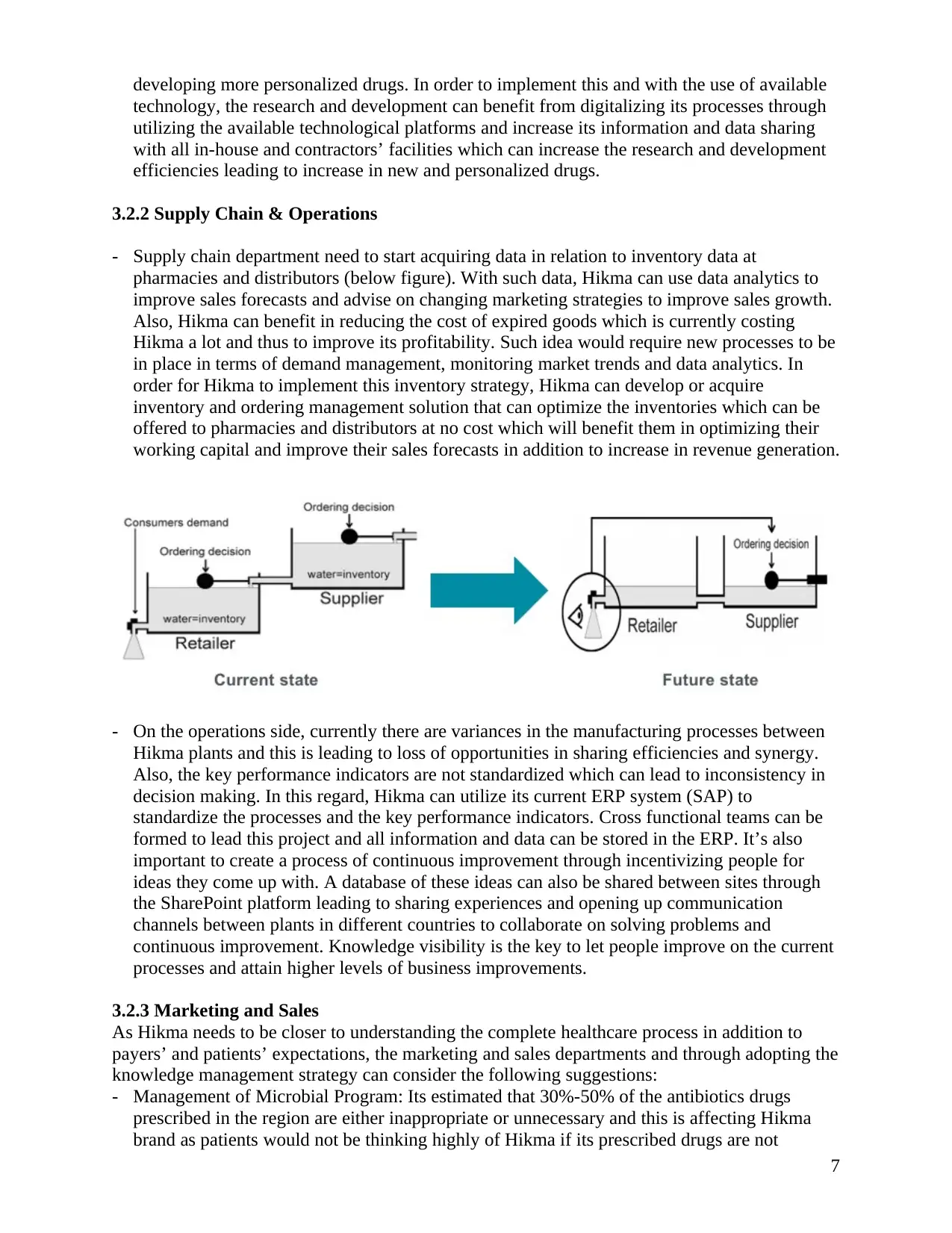
developing more personalized drugs. In order to implement this and with the use of available
technology, the research and development can benefit from digitalizing its processes through
utilizing the available technological platforms and increase its information and data sharing
with all in-house and contractors’ facilities which can increase the research and development
efficiencies leading to increase in new and personalized drugs.
3.2.2 Supply Chain & Operations
- Supply chain department need to start acquiring data in relation to inventory data at
pharmacies and distributors (below figure). With such data, Hikma can use data analytics to
improve sales forecasts and advise on changing marketing strategies to improve sales growth.
Also, Hikma can benefit in reducing the cost of expired goods which is currently costing
Hikma a lot and thus to improve its profitability. Such idea would require new processes to be
in place in terms of demand management, monitoring market trends and data analytics. In
order for Hikma to implement this inventory strategy, Hikma can develop or acquire
inventory and ordering management solution that can optimize the inventories which can be
offered to pharmacies and distributors at no cost which will benefit them in optimizing their
working capital and improve their sales forecasts in addition to increase in revenue generation.
- On the operations side, currently there are variances in the manufacturing processes between
Hikma plants and this is leading to loss of opportunities in sharing efficiencies and synergy.
Also, the key performance indicators are not standardized which can lead to inconsistency in
decision making. In this regard, Hikma can utilize its current ERP system (SAP) to
standardize the processes and the key performance indicators. Cross functional teams can be
formed to lead this project and all information and data can be stored in the ERP. It’s also
important to create a process of continuous improvement through incentivizing people for
ideas they come up with. A database of these ideas can also be shared between sites through
the SharePoint platform leading to sharing experiences and opening up communication
channels between plants in different countries to collaborate on solving problems and
continuous improvement. Knowledge visibility is the key to let people improve on the current
processes and attain higher levels of business improvements.
3.2.3 Marketing and Sales
As Hikma needs to be closer to understanding the complete healthcare process in addition to
payers’ and patients’ expectations, the marketing and sales departments and through adopting the
knowledge management strategy can consider the following suggestions:
- Management of Microbial Program: Its estimated that 30%-50% of the antibiotics drugs
prescribed in the region are either inappropriate or unnecessary and this is affecting Hikma
brand as patients would not be thinking highly of Hikma if its prescribed drugs are not
7
technology, the research and development can benefit from digitalizing its processes through
utilizing the available technological platforms and increase its information and data sharing
with all in-house and contractors’ facilities which can increase the research and development
efficiencies leading to increase in new and personalized drugs.
3.2.2 Supply Chain & Operations
- Supply chain department need to start acquiring data in relation to inventory data at
pharmacies and distributors (below figure). With such data, Hikma can use data analytics to
improve sales forecasts and advise on changing marketing strategies to improve sales growth.
Also, Hikma can benefit in reducing the cost of expired goods which is currently costing
Hikma a lot and thus to improve its profitability. Such idea would require new processes to be
in place in terms of demand management, monitoring market trends and data analytics. In
order for Hikma to implement this inventory strategy, Hikma can develop or acquire
inventory and ordering management solution that can optimize the inventories which can be
offered to pharmacies and distributors at no cost which will benefit them in optimizing their
working capital and improve their sales forecasts in addition to increase in revenue generation.
- On the operations side, currently there are variances in the manufacturing processes between
Hikma plants and this is leading to loss of opportunities in sharing efficiencies and synergy.
Also, the key performance indicators are not standardized which can lead to inconsistency in
decision making. In this regard, Hikma can utilize its current ERP system (SAP) to
standardize the processes and the key performance indicators. Cross functional teams can be
formed to lead this project and all information and data can be stored in the ERP. It’s also
important to create a process of continuous improvement through incentivizing people for
ideas they come up with. A database of these ideas can also be shared between sites through
the SharePoint platform leading to sharing experiences and opening up communication
channels between plants in different countries to collaborate on solving problems and
continuous improvement. Knowledge visibility is the key to let people improve on the current
processes and attain higher levels of business improvements.
3.2.3 Marketing and Sales
As Hikma needs to be closer to understanding the complete healthcare process in addition to
payers’ and patients’ expectations, the marketing and sales departments and through adopting the
knowledge management strategy can consider the following suggestions:
- Management of Microbial Program: Its estimated that 30%-50% of the antibiotics drugs
prescribed in the region are either inappropriate or unnecessary and this is affecting Hikma
brand as patients would not be thinking highly of Hikma if its prescribed drugs are not
7
Paraphrase This Document
Need a fresh take? Get an instant paraphrase of this document with our AI Paraphraser
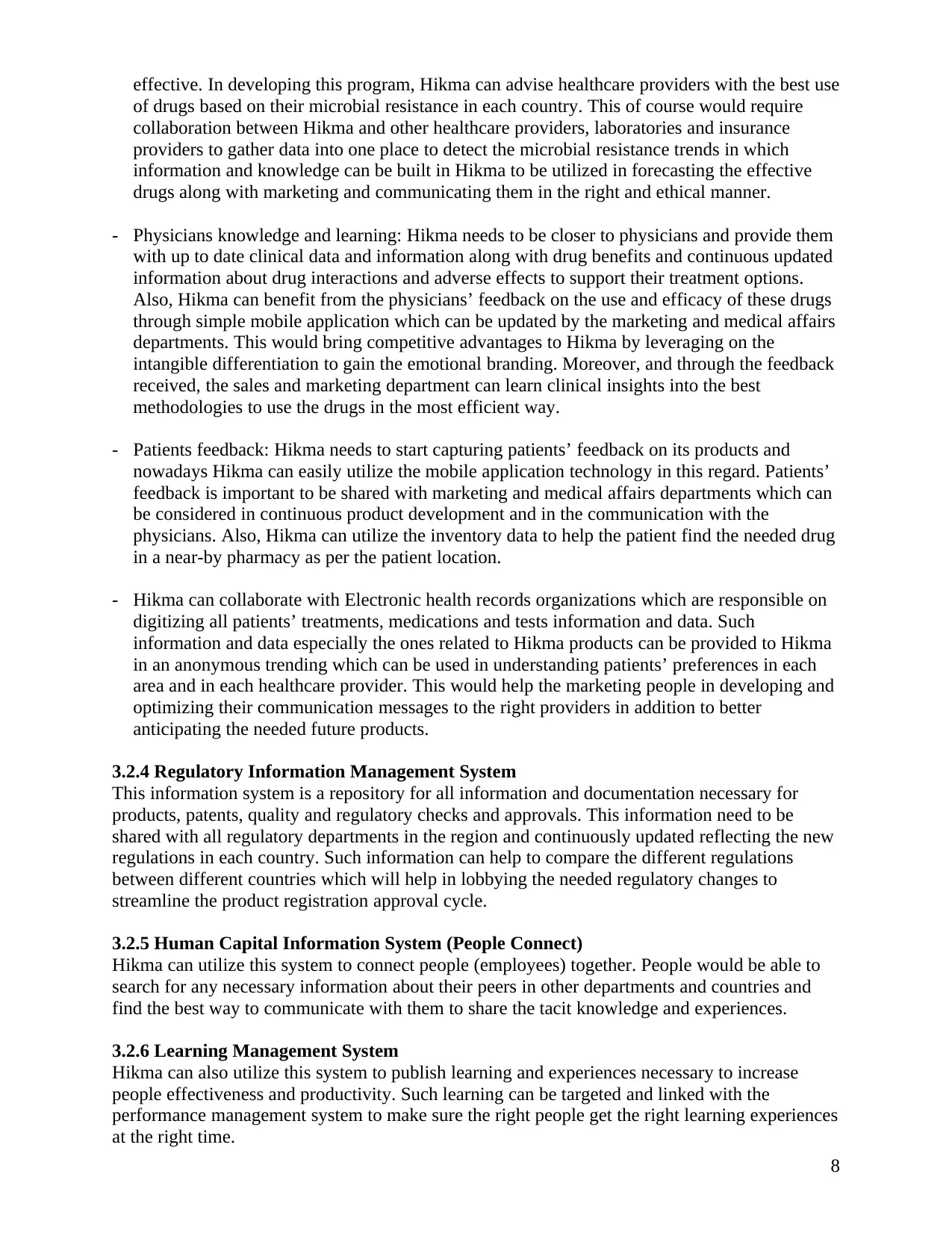
effective. In developing this program, Hikma can advise healthcare providers with the best use
of drugs based on their microbial resistance in each country. This of course would require
collaboration between Hikma and other healthcare providers, laboratories and insurance
providers to gather data into one place to detect the microbial resistance trends in which
information and knowledge can be built in Hikma to be utilized in forecasting the effective
drugs along with marketing and communicating them in the right and ethical manner.
- Physicians knowledge and learning: Hikma needs to be closer to physicians and provide them
with up to date clinical data and information along with drug benefits and continuous updated
information about drug interactions and adverse effects to support their treatment options.
Also, Hikma can benefit from the physicians’ feedback on the use and efficacy of these drugs
through simple mobile application which can be updated by the marketing and medical affairs
departments. This would bring competitive advantages to Hikma by leveraging on the
intangible differentiation to gain the emotional branding. Moreover, and through the feedback
received, the sales and marketing department can learn clinical insights into the best
methodologies to use the drugs in the most efficient way.
- Patients feedback: Hikma needs to start capturing patients’ feedback on its products and
nowadays Hikma can easily utilize the mobile application technology in this regard. Patients’
feedback is important to be shared with marketing and medical affairs departments which can
be considered in continuous product development and in the communication with the
physicians. Also, Hikma can utilize the inventory data to help the patient find the needed drug
in a near-by pharmacy as per the patient location.
- Hikma can collaborate with Electronic health records organizations which are responsible on
digitizing all patients’ treatments, medications and tests information and data. Such
information and data especially the ones related to Hikma products can be provided to Hikma
in an anonymous trending which can be used in understanding patients’ preferences in each
area and in each healthcare provider. This would help the marketing people in developing and
optimizing their communication messages to the right providers in addition to better
anticipating the needed future products.
3.2.4 Regulatory Information Management System
This information system is a repository for all information and documentation necessary for
products, patents, quality and regulatory checks and approvals. This information need to be
shared with all regulatory departments in the region and continuously updated reflecting the new
regulations in each country. Such information can help to compare the different regulations
between different countries which will help in lobbying the needed regulatory changes to
streamline the product registration approval cycle.
3.2.5 Human Capital Information System (People Connect)
Hikma can utilize this system to connect people (employees) together. People would be able to
search for any necessary information about their peers in other departments and countries and
find the best way to communicate with them to share the tacit knowledge and experiences.
3.2.6 Learning Management System
Hikma can also utilize this system to publish learning and experiences necessary to increase
people effectiveness and productivity. Such learning can be targeted and linked with the
performance management system to make sure the right people get the right learning experiences
at the right time.
8
of drugs based on their microbial resistance in each country. This of course would require
collaboration between Hikma and other healthcare providers, laboratories and insurance
providers to gather data into one place to detect the microbial resistance trends in which
information and knowledge can be built in Hikma to be utilized in forecasting the effective
drugs along with marketing and communicating them in the right and ethical manner.
- Physicians knowledge and learning: Hikma needs to be closer to physicians and provide them
with up to date clinical data and information along with drug benefits and continuous updated
information about drug interactions and adverse effects to support their treatment options.
Also, Hikma can benefit from the physicians’ feedback on the use and efficacy of these drugs
through simple mobile application which can be updated by the marketing and medical affairs
departments. This would bring competitive advantages to Hikma by leveraging on the
intangible differentiation to gain the emotional branding. Moreover, and through the feedback
received, the sales and marketing department can learn clinical insights into the best
methodologies to use the drugs in the most efficient way.
- Patients feedback: Hikma needs to start capturing patients’ feedback on its products and
nowadays Hikma can easily utilize the mobile application technology in this regard. Patients’
feedback is important to be shared with marketing and medical affairs departments which can
be considered in continuous product development and in the communication with the
physicians. Also, Hikma can utilize the inventory data to help the patient find the needed drug
in a near-by pharmacy as per the patient location.
- Hikma can collaborate with Electronic health records organizations which are responsible on
digitizing all patients’ treatments, medications and tests information and data. Such
information and data especially the ones related to Hikma products can be provided to Hikma
in an anonymous trending which can be used in understanding patients’ preferences in each
area and in each healthcare provider. This would help the marketing people in developing and
optimizing their communication messages to the right providers in addition to better
anticipating the needed future products.
3.2.4 Regulatory Information Management System
This information system is a repository for all information and documentation necessary for
products, patents, quality and regulatory checks and approvals. This information need to be
shared with all regulatory departments in the region and continuously updated reflecting the new
regulations in each country. Such information can help to compare the different regulations
between different countries which will help in lobbying the needed regulatory changes to
streamline the product registration approval cycle.
3.2.5 Human Capital Information System (People Connect)
Hikma can utilize this system to connect people (employees) together. People would be able to
search for any necessary information about their peers in other departments and countries and
find the best way to communicate with them to share the tacit knowledge and experiences.
3.2.6 Learning Management System
Hikma can also utilize this system to publish learning and experiences necessary to increase
people effectiveness and productivity. Such learning can be targeted and linked with the
performance management system to make sure the right people get the right learning experiences
at the right time.
8
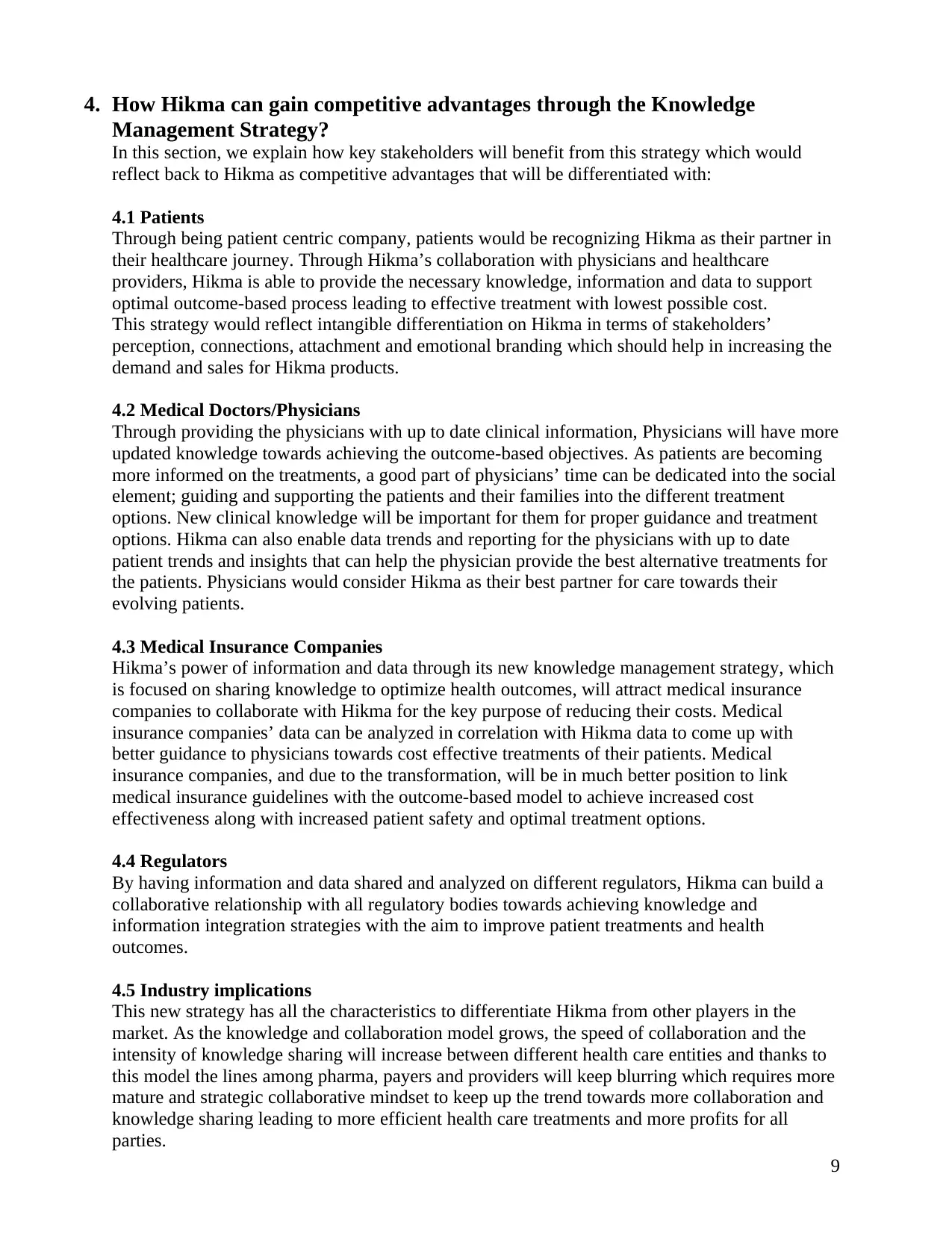
4. How Hikma can gain competitive advantages through the Knowledge
Management Strategy?
In this section, we explain how key stakeholders will benefit from this strategy which would
reflect back to Hikma as competitive advantages that will be differentiated with:
4.1 Patients
Through being patient centric company, patients would be recognizing Hikma as their partner in
their healthcare journey. Through Hikma’s collaboration with physicians and healthcare
providers, Hikma is able to provide the necessary knowledge, information and data to support
optimal outcome-based process leading to effective treatment with lowest possible cost.
This strategy would reflect intangible differentiation on Hikma in terms of stakeholders’
perception, connections, attachment and emotional branding which should help in increasing the
demand and sales for Hikma products.
4.2 Medical Doctors/Physicians
Through providing the physicians with up to date clinical information, Physicians will have more
updated knowledge towards achieving the outcome-based objectives. As patients are becoming
more informed on the treatments, a good part of physicians’ time can be dedicated into the social
element; guiding and supporting the patients and their families into the different treatment
options. New clinical knowledge will be important for them for proper guidance and treatment
options. Hikma can also enable data trends and reporting for the physicians with up to date
patient trends and insights that can help the physician provide the best alternative treatments for
the patients. Physicians would consider Hikma as their best partner for care towards their
evolving patients.
4.3 Medical Insurance Companies
Hikma’s power of information and data through its new knowledge management strategy, which
is focused on sharing knowledge to optimize health outcomes, will attract medical insurance
companies to collaborate with Hikma for the key purpose of reducing their costs. Medical
insurance companies’ data can be analyzed in correlation with Hikma data to come up with
better guidance to physicians towards cost effective treatments of their patients. Medical
insurance companies, and due to the transformation, will be in much better position to link
medical insurance guidelines with the outcome-based model to achieve increased cost
effectiveness along with increased patient safety and optimal treatment options.
4.4 Regulators
By having information and data shared and analyzed on different regulators, Hikma can build a
collaborative relationship with all regulatory bodies towards achieving knowledge and
information integration strategies with the aim to improve patient treatments and health
outcomes.
4.5 Industry implications
This new strategy has all the characteristics to differentiate Hikma from other players in the
market. As the knowledge and collaboration model grows, the speed of collaboration and the
intensity of knowledge sharing will increase between different health care entities and thanks to
this model the lines among pharma, payers and providers will keep blurring which requires more
mature and strategic collaborative mindset to keep up the trend towards more collaboration and
knowledge sharing leading to more efficient health care treatments and more profits for all
parties.
9
Management Strategy?
In this section, we explain how key stakeholders will benefit from this strategy which would
reflect back to Hikma as competitive advantages that will be differentiated with:
4.1 Patients
Through being patient centric company, patients would be recognizing Hikma as their partner in
their healthcare journey. Through Hikma’s collaboration with physicians and healthcare
providers, Hikma is able to provide the necessary knowledge, information and data to support
optimal outcome-based process leading to effective treatment with lowest possible cost.
This strategy would reflect intangible differentiation on Hikma in terms of stakeholders’
perception, connections, attachment and emotional branding which should help in increasing the
demand and sales for Hikma products.
4.2 Medical Doctors/Physicians
Through providing the physicians with up to date clinical information, Physicians will have more
updated knowledge towards achieving the outcome-based objectives. As patients are becoming
more informed on the treatments, a good part of physicians’ time can be dedicated into the social
element; guiding and supporting the patients and their families into the different treatment
options. New clinical knowledge will be important for them for proper guidance and treatment
options. Hikma can also enable data trends and reporting for the physicians with up to date
patient trends and insights that can help the physician provide the best alternative treatments for
the patients. Physicians would consider Hikma as their best partner for care towards their
evolving patients.
4.3 Medical Insurance Companies
Hikma’s power of information and data through its new knowledge management strategy, which
is focused on sharing knowledge to optimize health outcomes, will attract medical insurance
companies to collaborate with Hikma for the key purpose of reducing their costs. Medical
insurance companies’ data can be analyzed in correlation with Hikma data to come up with
better guidance to physicians towards cost effective treatments of their patients. Medical
insurance companies, and due to the transformation, will be in much better position to link
medical insurance guidelines with the outcome-based model to achieve increased cost
effectiveness along with increased patient safety and optimal treatment options.
4.4 Regulators
By having information and data shared and analyzed on different regulators, Hikma can build a
collaborative relationship with all regulatory bodies towards achieving knowledge and
information integration strategies with the aim to improve patient treatments and health
outcomes.
4.5 Industry implications
This new strategy has all the characteristics to differentiate Hikma from other players in the
market. As the knowledge and collaboration model grows, the speed of collaboration and the
intensity of knowledge sharing will increase between different health care entities and thanks to
this model the lines among pharma, payers and providers will keep blurring which requires more
mature and strategic collaborative mindset to keep up the trend towards more collaboration and
knowledge sharing leading to more efficient health care treatments and more profits for all
parties.
9
⊘ This is a preview!⊘
Do you want full access?
Subscribe today to unlock all pages.

Trusted by 1+ million students worldwide
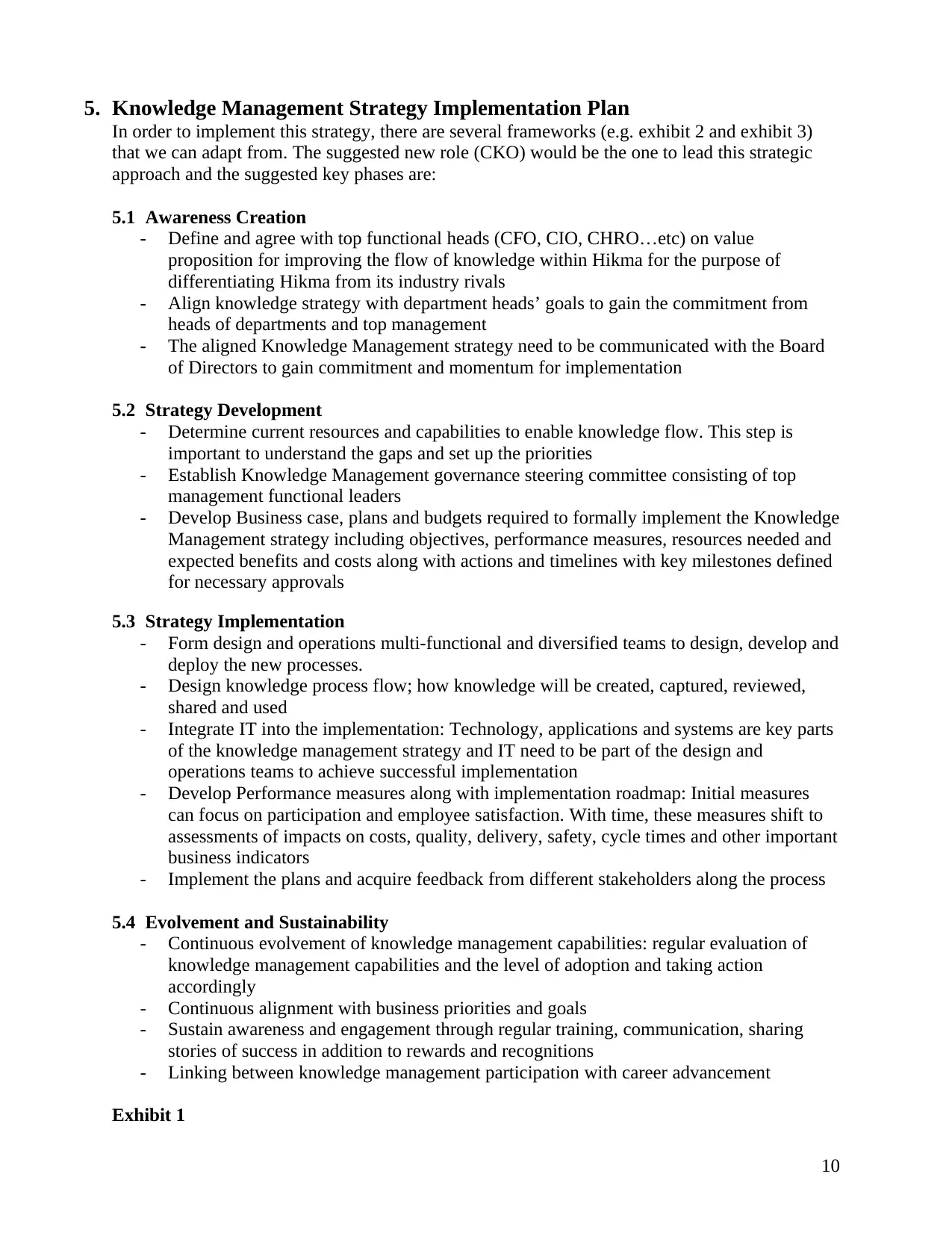
5. Knowledge Management Strategy Implementation Plan
In order to implement this strategy, there are several frameworks (e.g. exhibit 2 and exhibit 3)
that we can adapt from. The suggested new role (CKO) would be the one to lead this strategic
approach and the suggested key phases are:
5.1 Awareness Creation
- Define and agree with top functional heads (CFO, CIO, CHRO…etc) on value
proposition for improving the flow of knowledge within Hikma for the purpose of
differentiating Hikma from its industry rivals
- Align knowledge strategy with department heads’ goals to gain the commitment from
heads of departments and top management
- The aligned Knowledge Management strategy need to be communicated with the Board
of Directors to gain commitment and momentum for implementation
5.2 Strategy Development
- Determine current resources and capabilities to enable knowledge flow. This step is
important to understand the gaps and set up the priorities
- Establish Knowledge Management governance steering committee consisting of top
management functional leaders
- Develop Business case, plans and budgets required to formally implement the Knowledge
Management strategy including objectives, performance measures, resources needed and
expected benefits and costs along with actions and timelines with key milestones defined
for necessary approvals
5.3 Strategy Implementation
- Form design and operations multi-functional and diversified teams to design, develop and
deploy the new processes.
- Design knowledge process flow; how knowledge will be created, captured, reviewed,
shared and used
- Integrate IT into the implementation: Technology, applications and systems are key parts
of the knowledge management strategy and IT need to be part of the design and
operations teams to achieve successful implementation
- Develop Performance measures along with implementation roadmap: Initial measures
can focus on participation and employee satisfaction. With time, these measures shift to
assessments of impacts on costs, quality, delivery, safety, cycle times and other important
business indicators
- Implement the plans and acquire feedback from different stakeholders along the process
5.4 Evolvement and Sustainability
- Continuous evolvement of knowledge management capabilities: regular evaluation of
knowledge management capabilities and the level of adoption and taking action
accordingly
- Continuous alignment with business priorities and goals
- Sustain awareness and engagement through regular training, communication, sharing
stories of success in addition to rewards and recognitions
- Linking between knowledge management participation with career advancement
Exhibit 1
10
In order to implement this strategy, there are several frameworks (e.g. exhibit 2 and exhibit 3)
that we can adapt from. The suggested new role (CKO) would be the one to lead this strategic
approach and the suggested key phases are:
5.1 Awareness Creation
- Define and agree with top functional heads (CFO, CIO, CHRO…etc) on value
proposition for improving the flow of knowledge within Hikma for the purpose of
differentiating Hikma from its industry rivals
- Align knowledge strategy with department heads’ goals to gain the commitment from
heads of departments and top management
- The aligned Knowledge Management strategy need to be communicated with the Board
of Directors to gain commitment and momentum for implementation
5.2 Strategy Development
- Determine current resources and capabilities to enable knowledge flow. This step is
important to understand the gaps and set up the priorities
- Establish Knowledge Management governance steering committee consisting of top
management functional leaders
- Develop Business case, plans and budgets required to formally implement the Knowledge
Management strategy including objectives, performance measures, resources needed and
expected benefits and costs along with actions and timelines with key milestones defined
for necessary approvals
5.3 Strategy Implementation
- Form design and operations multi-functional and diversified teams to design, develop and
deploy the new processes.
- Design knowledge process flow; how knowledge will be created, captured, reviewed,
shared and used
- Integrate IT into the implementation: Technology, applications and systems are key parts
of the knowledge management strategy and IT need to be part of the design and
operations teams to achieve successful implementation
- Develop Performance measures along with implementation roadmap: Initial measures
can focus on participation and employee satisfaction. With time, these measures shift to
assessments of impacts on costs, quality, delivery, safety, cycle times and other important
business indicators
- Implement the plans and acquire feedback from different stakeholders along the process
5.4 Evolvement and Sustainability
- Continuous evolvement of knowledge management capabilities: regular evaluation of
knowledge management capabilities and the level of adoption and taking action
accordingly
- Continuous alignment with business priorities and goals
- Sustain awareness and engagement through regular training, communication, sharing
stories of success in addition to rewards and recognitions
- Linking between knowledge management participation with career advancement
Exhibit 1
10
Paraphrase This Document
Need a fresh take? Get an instant paraphrase of this document with our AI Paraphraser
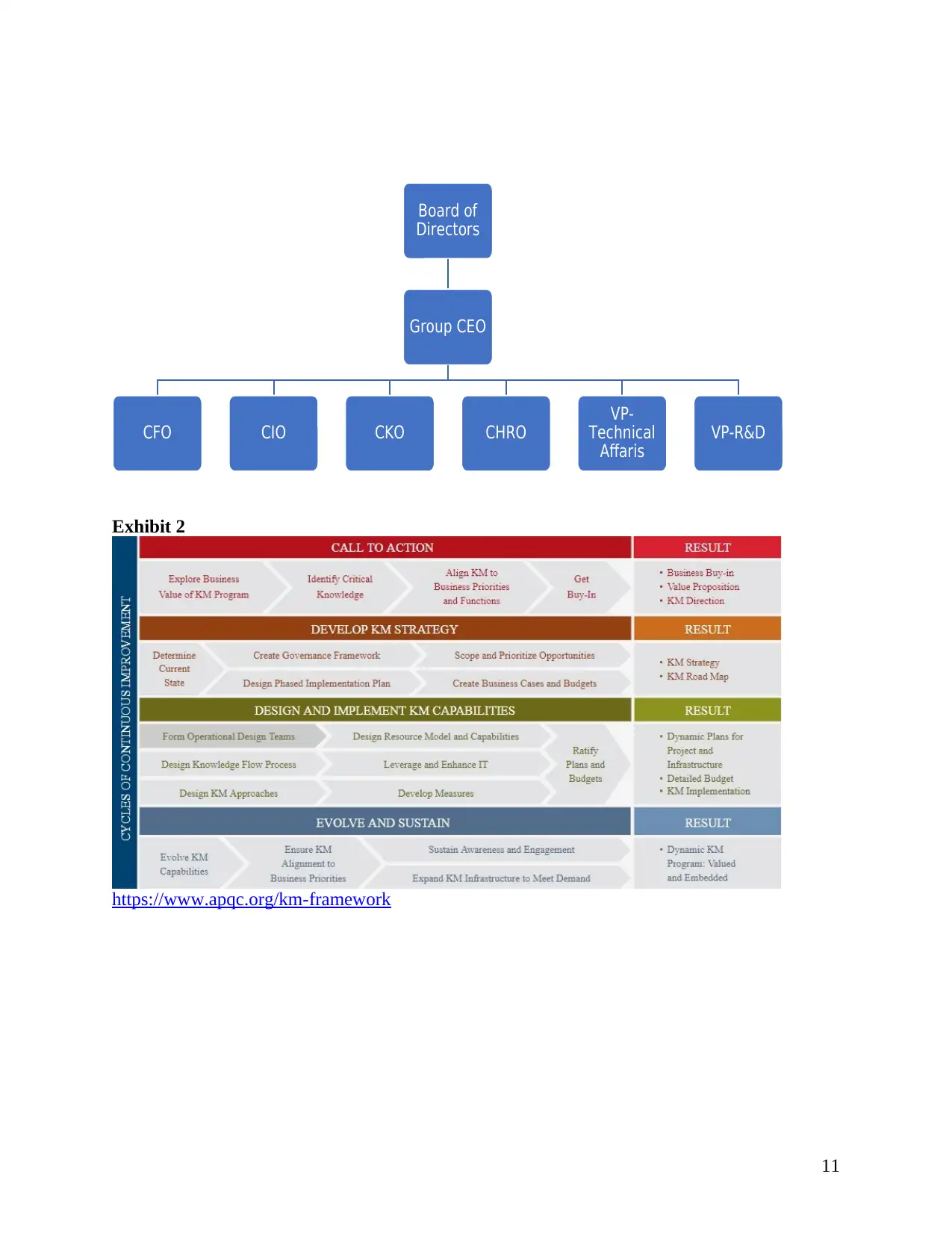
Exhibit 2
https://www.apqc.org/km-framework
Board of
Directors
Group CEO
CFO CIO CKO CHRO
VP-
Technical
Affaris
VP-R&D
11
https://www.apqc.org/km-framework
Board of
Directors
Group CEO
CFO CIO CKO CHRO
VP-
Technical
Affaris
VP-R&D
11
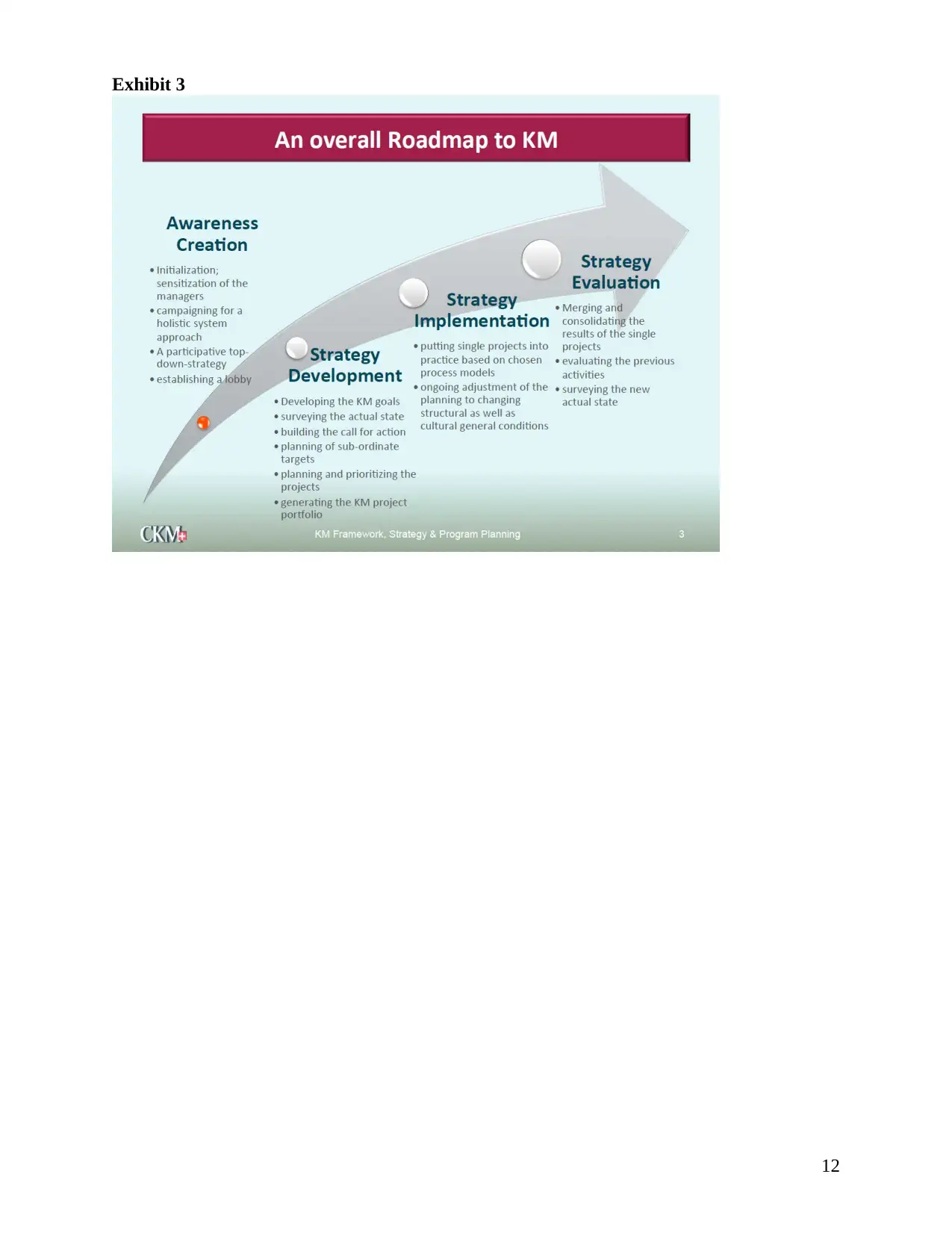
Exhibit 3
12
12
⊘ This is a preview!⊘
Do you want full access?
Subscribe today to unlock all pages.

Trusted by 1+ million students worldwide
1 out of 12
Related Documents
Your All-in-One AI-Powered Toolkit for Academic Success.
+13062052269
info@desklib.com
Available 24*7 on WhatsApp / Email
![[object Object]](/_next/static/media/star-bottom.7253800d.svg)
Unlock your academic potential
Copyright © 2020–2025 A2Z Services. All Rights Reserved. Developed and managed by ZUCOL.



